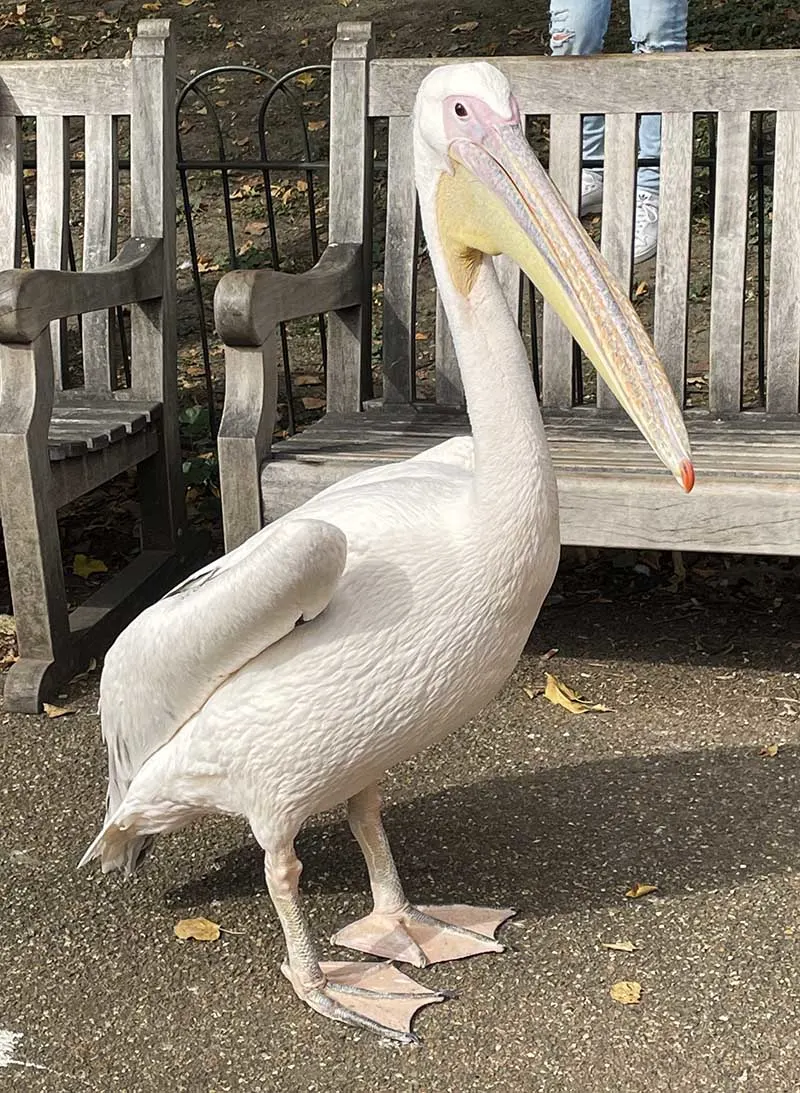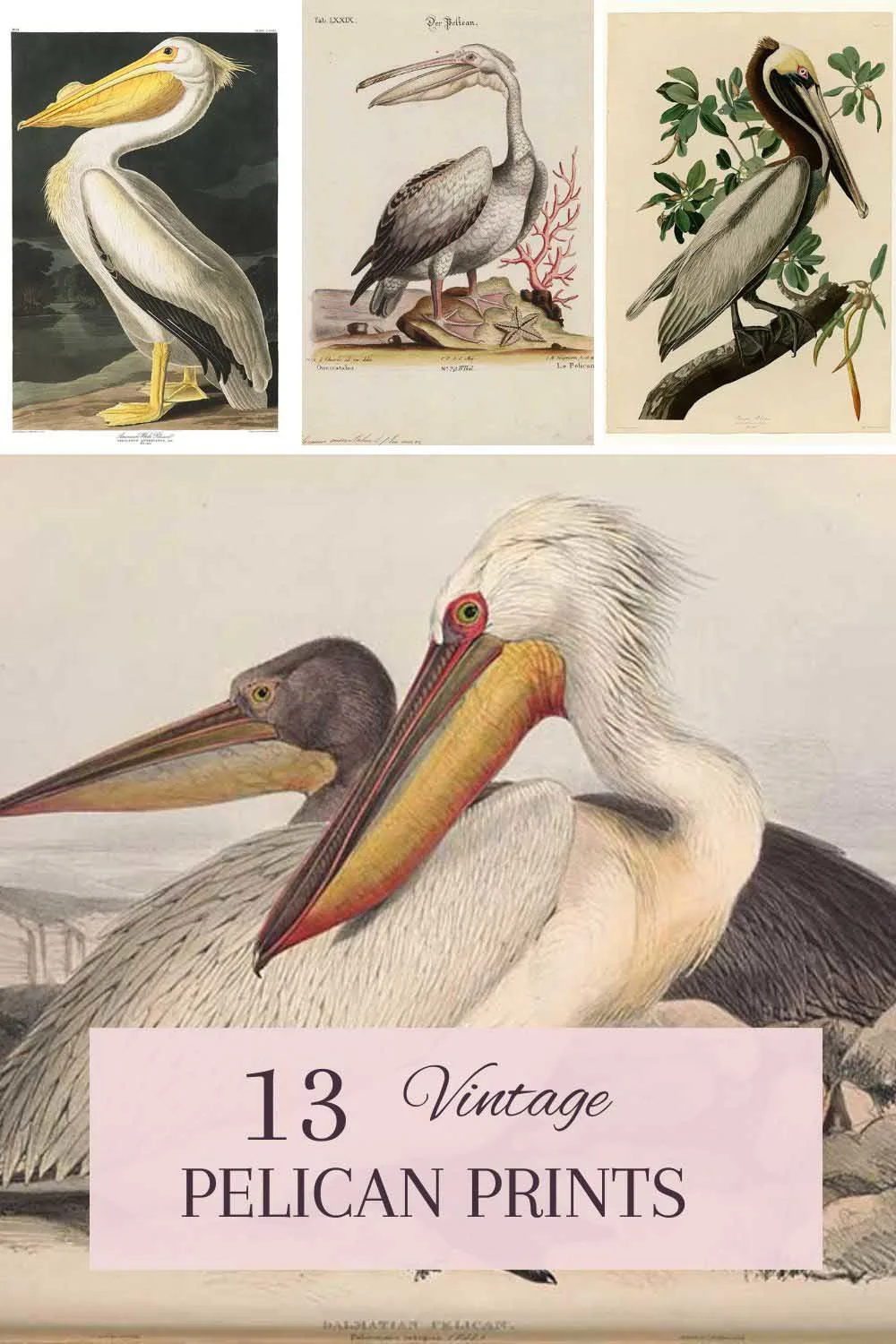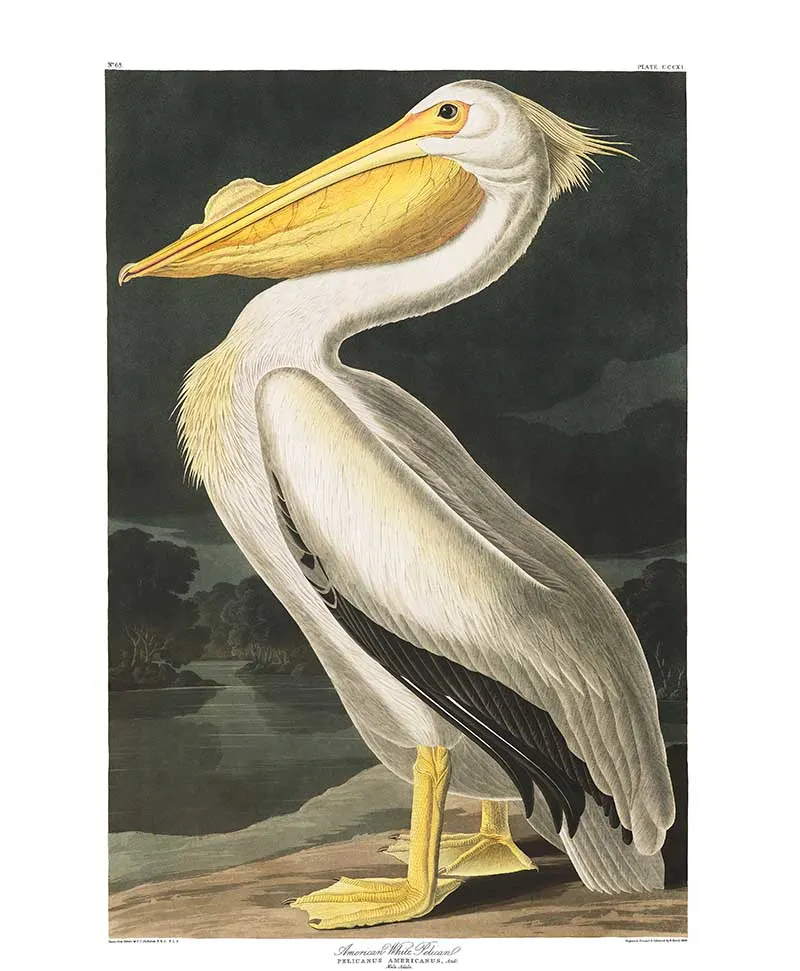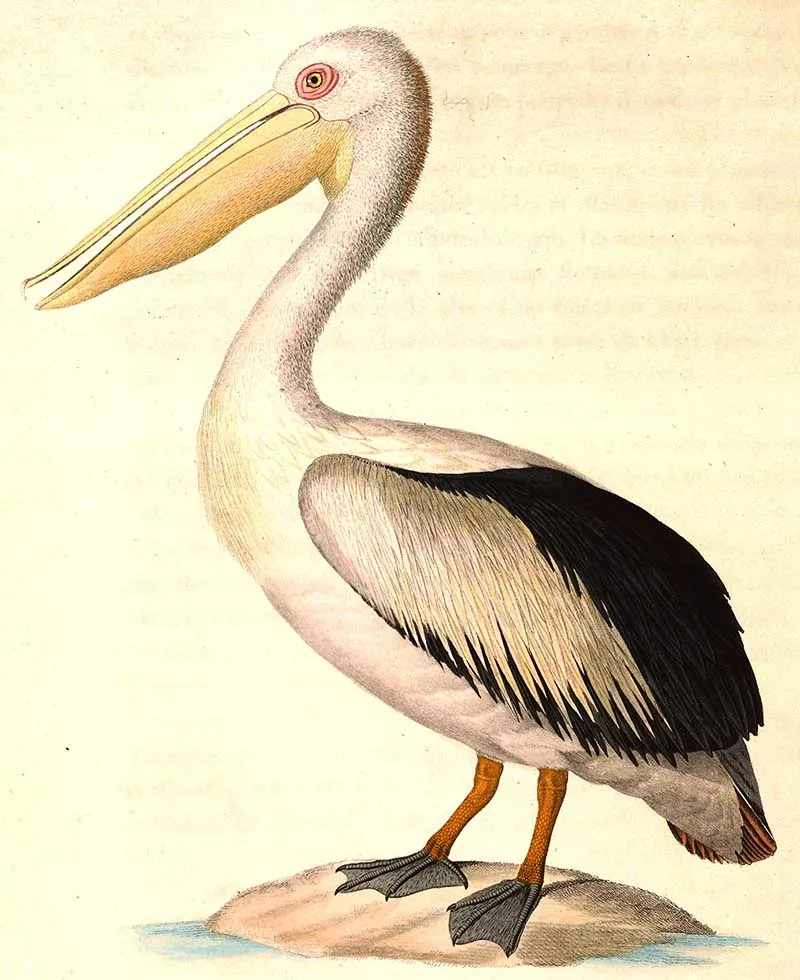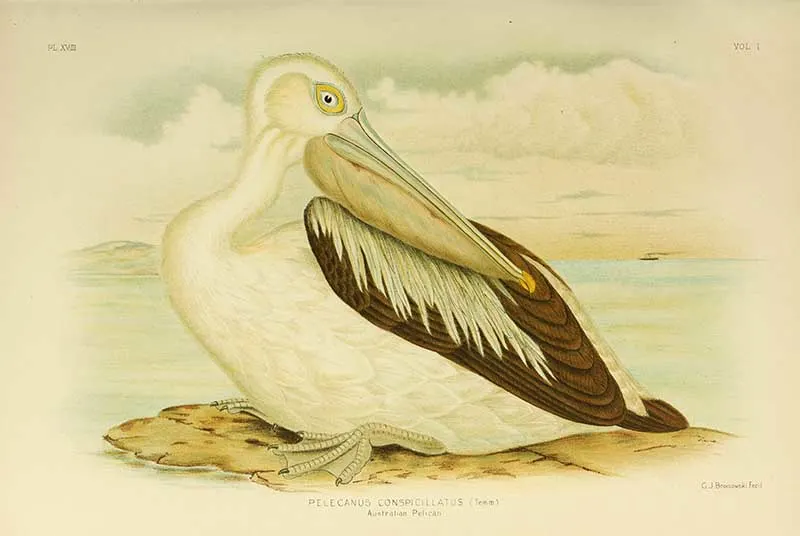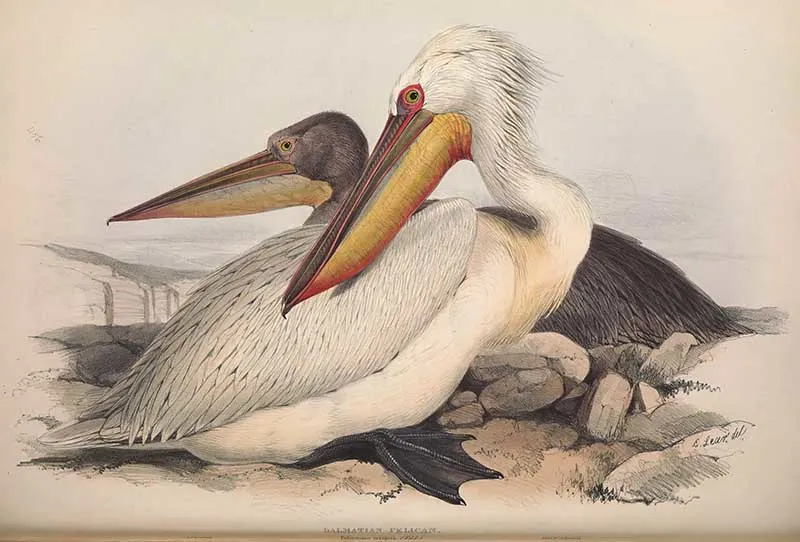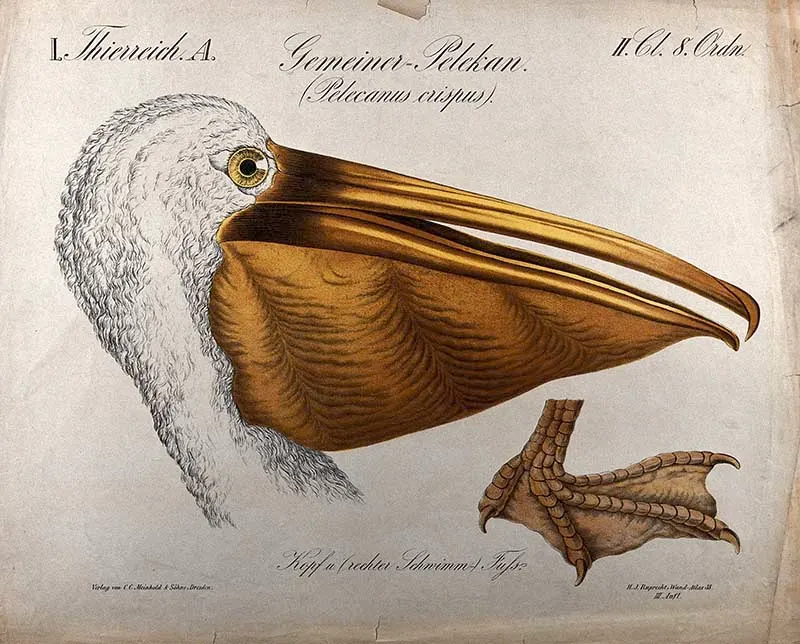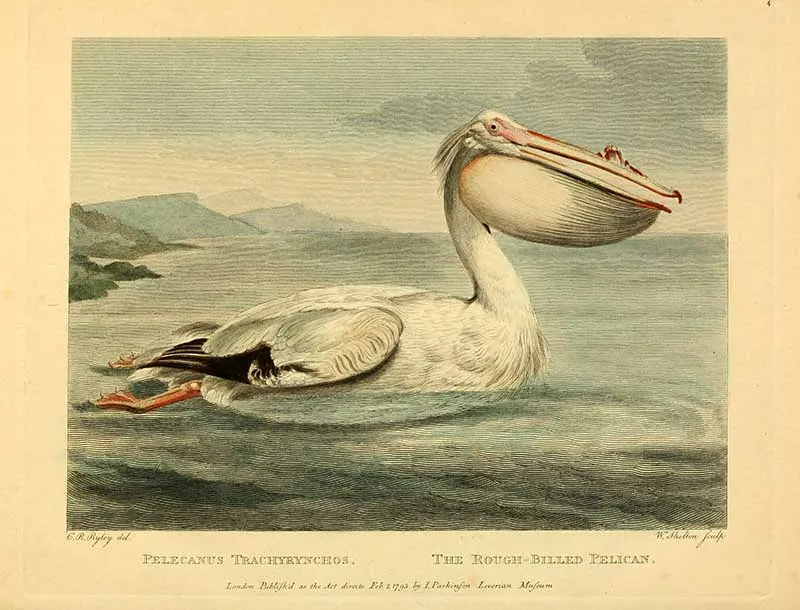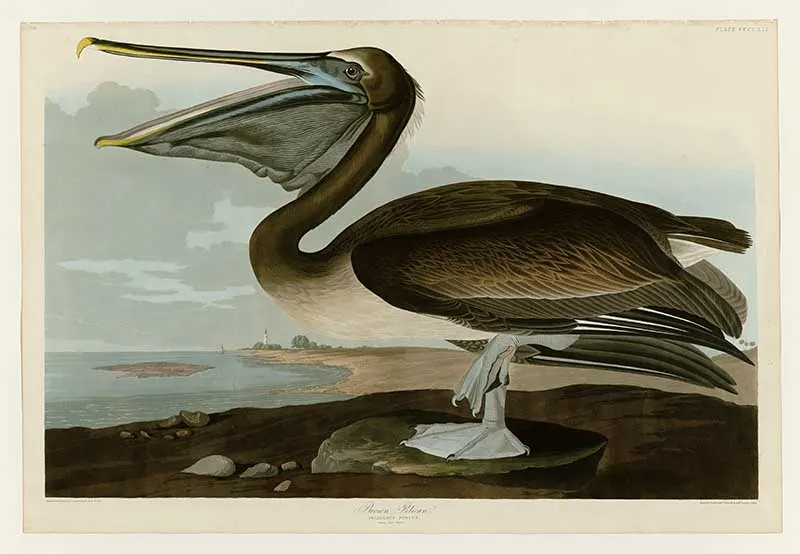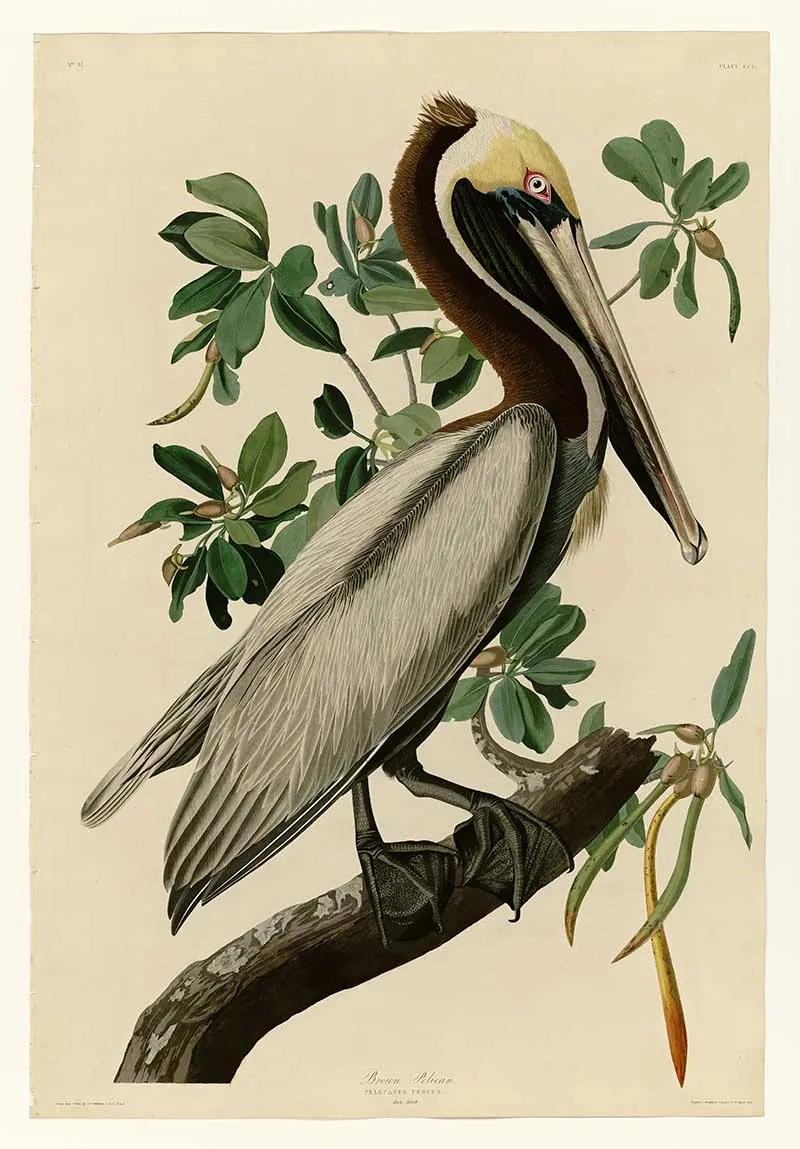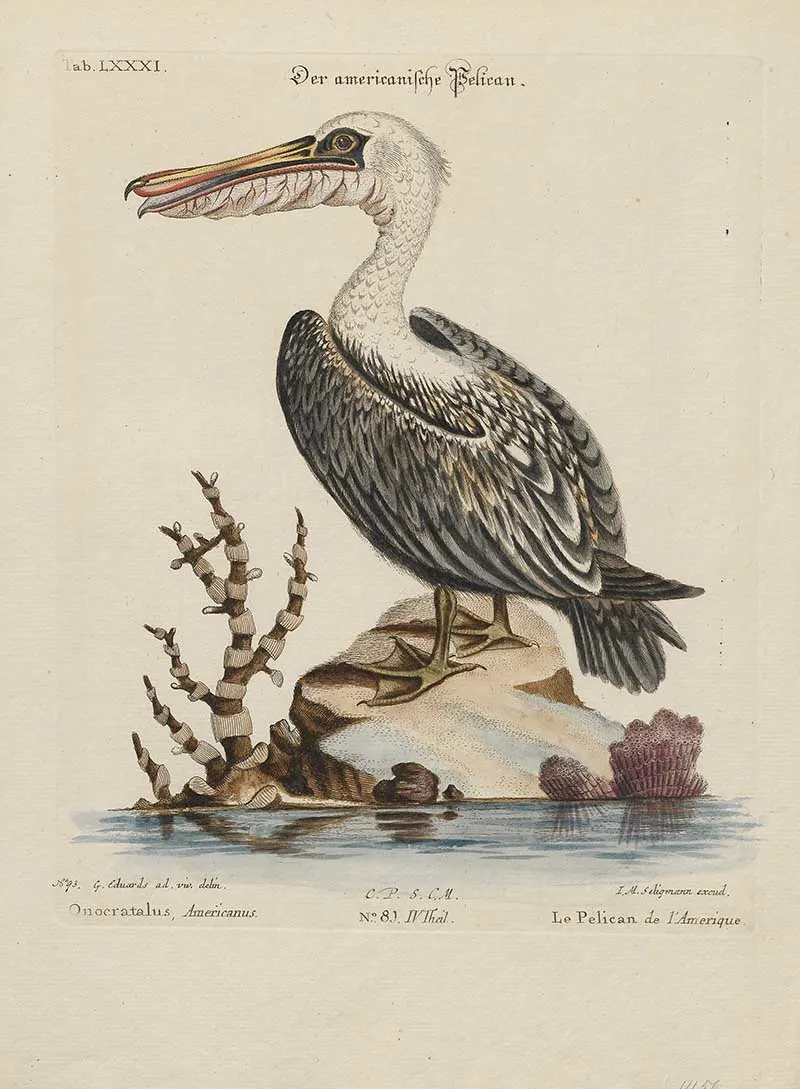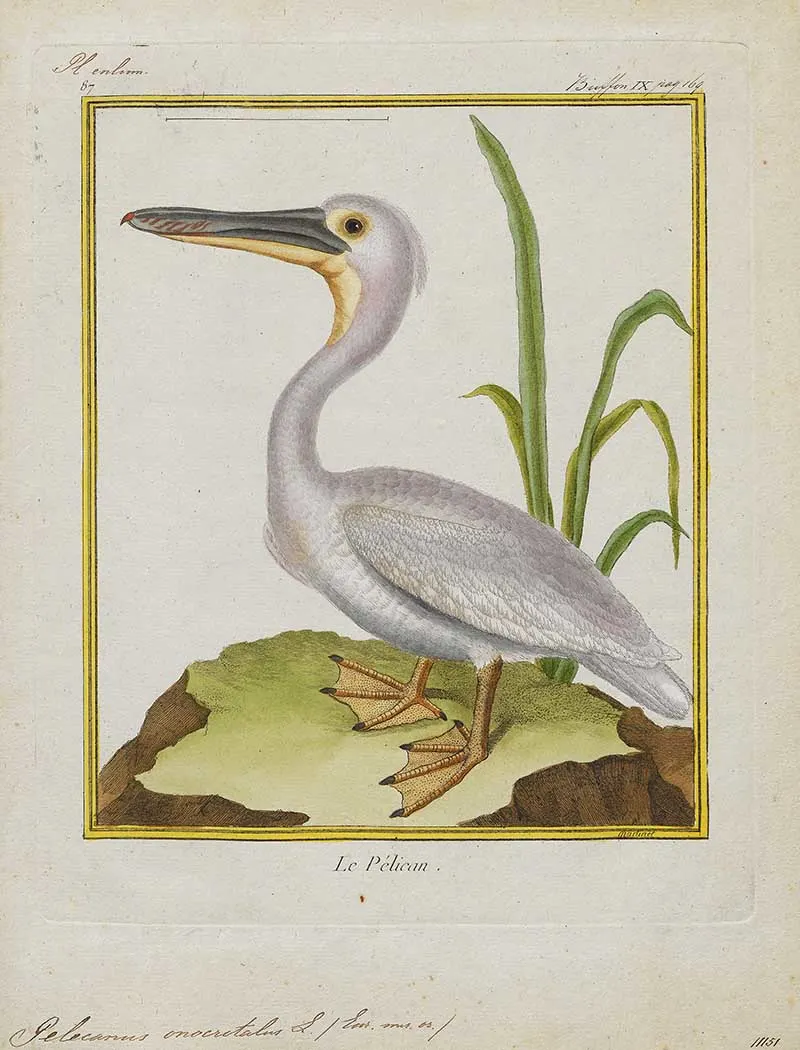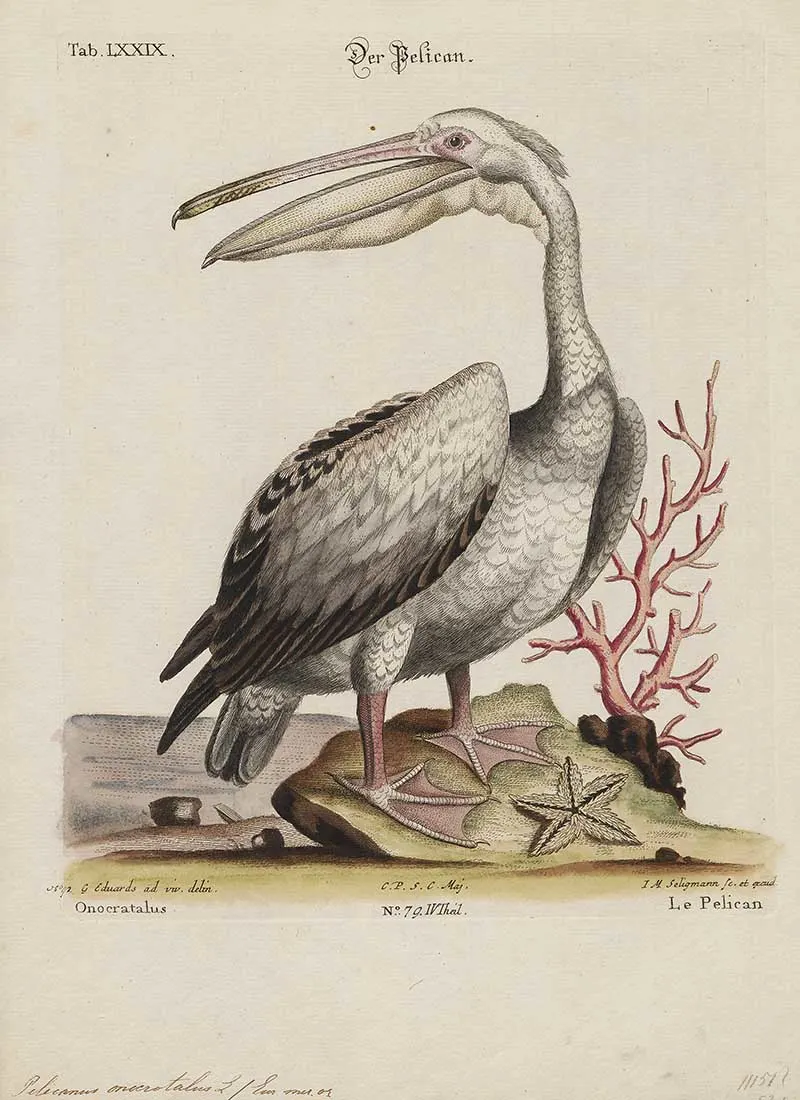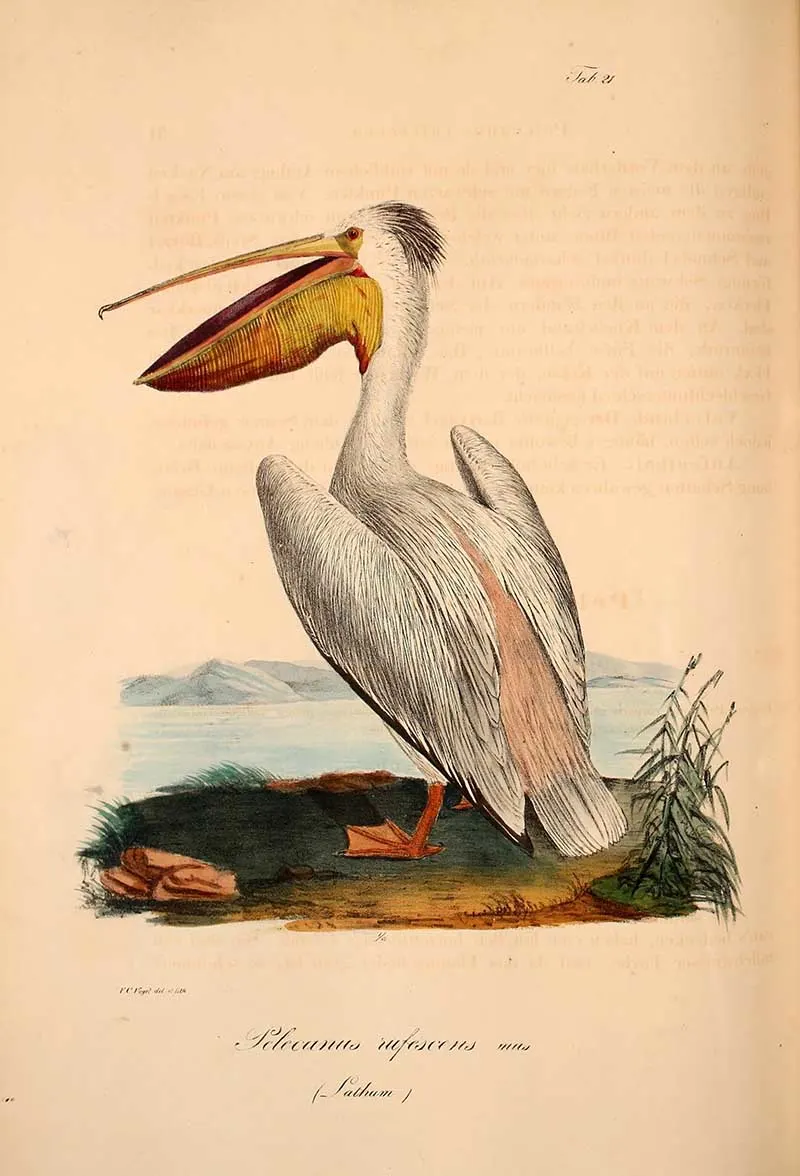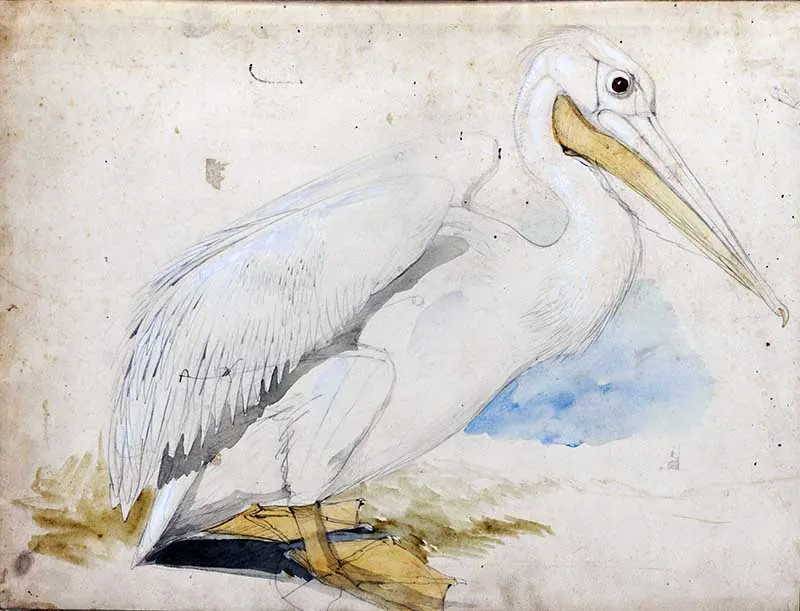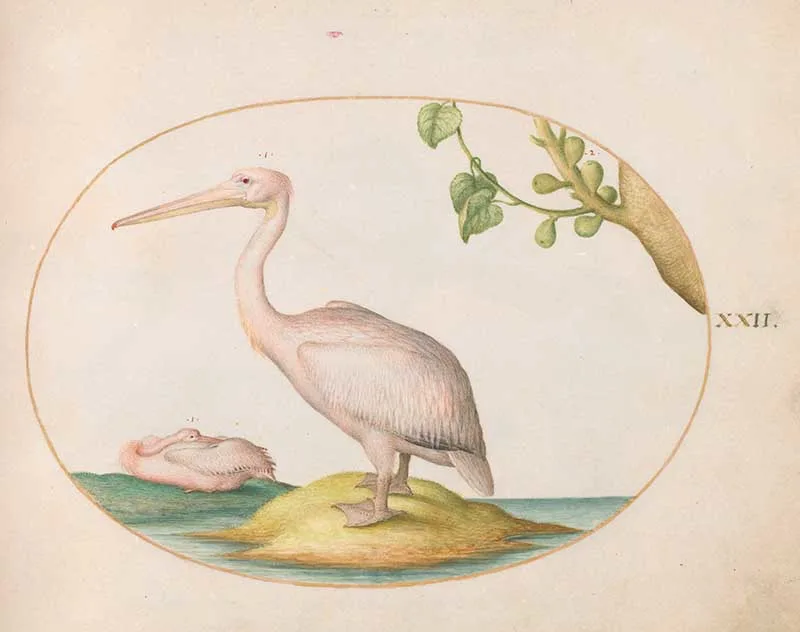Inside: Three Audubon pelican prints and another ten stunning vintage pelican illustrations, in the Public Domain and free to download and print.
Last week I walked through St Jame’s Park in London (next to Buckingham Palace). A day after the Queen’s funeral, I came face to face with a large Pelican on the path. I don’t know if it had flown in specially to pay its respects, but it was an enormous and impressive bird. I’d never been up so close to a pelican before.
When I got home, I learned more about them and found some stunning vintage Pelican prints and illustrations. Audubon’s pelican print from his famous book “The Birds of America” was the most impressive. I’ve seen that print often in interior shops, along with his renowned flamingo prints.
Pelicans featured under the letter P in the Pictural Alphabet of Birds.
A Few Facts About Pelicans
- There are eight pelican species, and the bird is found on all continents except Antarctica.
- Pelican species fall into two distinct groups, four white feathered ground-nesting species and four brown or grey-plumaged tree nesting species.
- Due to their mainly fish diet, the birds live near water. However, they do eat creatures other than fish, to the horror of tourists in St James park (2006) who witnessed a pelican swallow a live pigeon whole.
- Pelicans are social animals that live in colonies that can include hundreds of birds.
- They are one of the world’s largest birds, ranging in size from 1-2 meters, 5-13kg and with a wingspan of up to 3 meters.
- The most distinctive feature of Pelicans is its massive bill, the largest of all bird species and can reach up to 18 inches in length.
- Their throat pouch can hold up to 14 litres of water. The pouch is used mainly for feeding, but they also flap it around to cool themselves down.
- It’s an ancient bird; fossil evidence shows that the Pelicans were around 36 million years ago.
- The great white pelican is the national bird of Romania. The brown pelican is the national bird of Saint Kitts and Nevis, and Barbados. It’s also the US state bird of Louisiana, the “Pelican State“.
- The collective noun for a group of pelicans is a scoop.
- There is a famous limerick about the Pelican by Dixon Lanier Merritt (1910):
A wonderful bird is the pelican His bill will hold more than his belican He can take in his beak Food enough for a week But I'm damned if I see how the helican
The Vintage Pelican Prints & Illustrations
To download the peilican print you want click on the title above that illustration. A larger resolution image will open in a new window in your browser. If you right click on that picture you can save or print it.
All the images includinge the Audubon Pelican print are in the Public Domain and therefore copyright free.
1. The Audubon Pelican Print
American White Pelican from Birds of America (1836) by John James Audubon (1785 – 1851 ), etched by Robert Havell (1793 – 1878).
The original Birds of America is the most expensive printed book in the world and a genuinely awe-inspiring classic. The Birds of America cost around £100,000 to produce in total – equal to £1.5 million today.
You’ll find other Audubon bird prints from this book in the collection of Heron prints and flamingo pictures.
2. The Australian Pelican
The Australian pelican is a predominantly white bird with black wings and a pink bill on the inland and coastal waters of Australasia. It has the longest bill of any living bird.
This print is from the book “Nouveau Recueil de Planches Coloriées d’Oiseaux” (New Collection of Coloured Plates of Birds), Temminck et al 1838.
3. The Birds of Australia Pelican (1890)
Australian pelican print from the “The Birds of Australia“, Broinowski.
4. Dalmation Pelican
The Dalmatian pelican is the largest species of pelican and perhaps the world’s biggest freshwater bird.
The vintage pelican illustration is from John Goulds “Bird of Europe”, 1837. John Gould provides the following description;
” A bird of such striking magnitude as the present having so long escaped observation even on the shores of Europe, what may we not expect from those more distant countries to which the scrutinizing eye of the naturalist has seldom penetrated? Although this species has been introduced to the notice of the scientific within the last few years only, it has doubtless long abounded where it is now found. The specimen from which our figure is taken was sent us by Baron de Feldegg, and was one of twenty-four killed by him on the shores of Dalmatia.“
5. Pelican Head and Foot
A detailed close-up drawing of a Pelican head and webbed foot. From the Welecome collection.
6. American White Pelican
From “Musei Leveriani Explicatio, Anglica et Latina”, Geroge Shaw et al 1792.
7. Audubon Brown Peilcan Print
The brown pelican feeds by diving for fish. It is found on the Atlantic Coast from New Jersey to the mouth of the Amazon River and along the Pacific Coast from British Columbia to Chile.
From John James Audubon’s book, The Birds of America.
8. Audubon Brown Pelican Print 2
9. Iconographia Zoologica Brown Pelican
Pelican illustration from the Iconographia Zoologica by George Edwards.
10. The Great White Pelican
This is the species of pelican I came across in St James’s Park London.
Another Pelican print from the Iconographia Zoologica collection at the Univeristy of Amsterdam.
11. George Edwards Great White Pelican
12. The Pink Backed Pelican
The pink-backed pelican is found in the swamps and shallow lakes of Africa and southern Arabia.
This pelican drawing is from the book “Atlas zu der Reise im Nördlichen Afrika” (Atlas to Voyage of Northern Africa), 1826.
13. Edward Lear Pelican
A watercolour painting of a Pelican by Edward Lear.
14. White Pelicans Hoefnagel
Two White Pelicans with a Sycamore Fig from Joris Hoefnagels Four Elements.
Don’t forget to check out the many other vintage bird prints on Pictureboxblue. These include Ostriches, Owls, Toucans and Cockatoos, to name a few.
If you fancy, you can Buy Me A Coffee Here.

